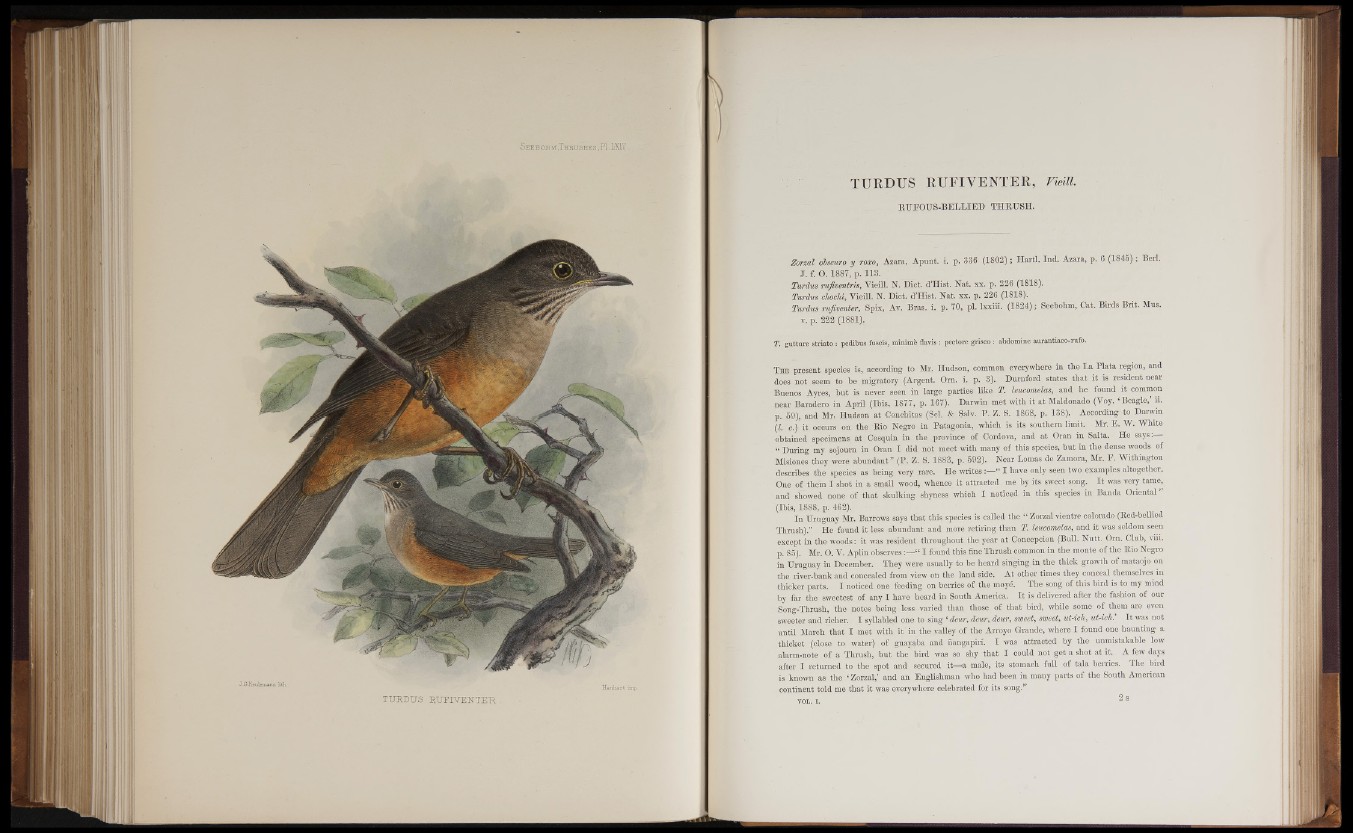
Z on al obscwro y roxo, Azara, Apunt. i. p. 336 (1802); Hartl. Ind. Azara, p. 6 (1845); Berl.
J. f. 0 . 1887, p. 113. ;
Turdus rufiventris, Vieill. N. Diet. d’Hist. Nat. xx. p. 226 (1818).
Turdus chochi, Vieill. N. Diet. d’Hist. Nat. xx. p. 226 (1818).
Turdus rufiventer, Spix, Av. Bras. i. p. 70, pi. lxxiii. (1824); Seebohm, Cat. Birds Brit. Mus.
y. p. 222 (1881).
T. gutture striato : pedibus fuscis, minime flavis : pectore griseo : abdomine aurantiaco-rufo.
T he present species is, according to Mr. Hudson, common everywhere in the La Plata region, and
does not seem to be migratory (Argent. Om. i. p. 3). Durnford states that it is resident near
Buenos Ayres, but is never seen in large parties like T. leucomelas, and he found it common
near Baradero in April (Ibis, 1877, p. 167). Darwin met with it at Maldonado (Voy. ‘Beagle,’ ii.
p. 59), and Mr. Hudson at Conchitas (Scl. & Salv. P. Z. S. 1868, p. 138). According to Darwin
(I. c.) it occurs on the Bio Negro in Patagonia, which is its southern limit. Mr. E. W. White
obtained specimens at Cosquin in the province of Cordova, and at Oran in Salta. He says.
“ During my sojourn in Oran I did not meet with many of this species, but in the dense woods of
Misiones they were abundant” (P. Z. S. 1883, p. 592). Near Lomas de Zamora, Mr. F. Withington
describes the species as being very rare. He writes “ I have only seen two examples altogether.
One of them I shot in a small wood, whence it attracted me by its sweet song. It was very tame,
and showed none of that skulking shyness which I noticed in this species in Banda Oriental
'(Ibis, 1888,;p. 462).
In Uruguay Mr. Barrows says that this species is called the.“ Zorzal vientre Colorado (Bed-bellied
Thrush).” He found it less abundant and more retiring than 21 leucomelas, and it was seldom seen
except in the woods: it was resident throughout the year at Concepcion (Bull. Nutt. Om. Club, viii.
p. 85). Mr. O. V. Aplin observes :-B ‘ I found this fine Thrush common in the monte of the Bio Negro
in Uruguay in December. They were usually to be heard singing in the thick growth of mataojo on
the river-bank and concealed from view on the land side. At other times they conceal themselves in
thicker parts. I noticed one feeding on berries of the moye. The song of this bird is to my mind
by far the sweetest of any I have heard in South America. It is delivered after the fashion of our
Song-Thrush, the notes being less varied than those of that bird, while some of them are even
sweeter and richer. I syllabled one to sing * deur, deur, deur, sweet, sweet, ut-ich, ut-ich.’ It was not
until March that I met with it' in the valley of the Arroyo Grande, where I found one haunting a
thicket (close to water) of guayaba and nangapiri. I was attracted by the unmistakable low
alarm-note of a Thrush, but the bird was so shy that I could not get a shot at it. A few days
after I returned to the spot and secured it—a male, its stomach full of tala berries. The bird
is known as the ‘Zorzal,’ and an Englishman who had been in many parts of the South American
continent told me that it was everywhere celebrated for its song.”
v o l . I. “2 °s